Lindy Hop
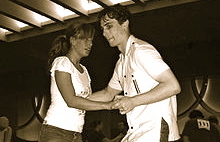
Chick Webb, Frankie Manning and the Birth of Lindy Hop
In this video, in his own words, we hear the Frankie Manning story, the great man is more of a god to us lindy hoppers, for his place in history and more recently for his role in the lindy revival of the 80’s and 90’s. He is sadly missed since his passing in 2009, we love you Frankie wherever you are. A transcript of the entire interview can be viewed here, In his own words Frankie describes his birthplace of Jacksonville, Florida and its connection with the baptist church, he describes what a swing is and the evolution of the lindy hop to this new sound, we hear about the savoy, its two battling bandstands and of Chick Webb the resident band leader who orchestrated the proceedings.” Read the full article here: http://kilkennyswing.com/the-history-…, Videos from Ken Burns wonderful documentary “Jazz” and http://www.pbs.org/jazz/.
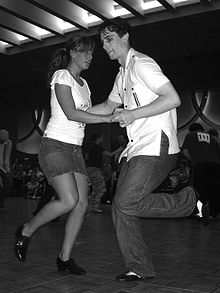 Dancing the Lindy Hop at the Sacramento Jazz Jubilee, Sacramento, California, US (2006)
Dancing the Lindy Hop at the Sacramento Jazz Jubilee, Sacramento, California, US (2006)
The Lindy Hop is an American dance that evolved in Harlem, New York City in the 1920’s and 1930’s and originally evolved with the jazz music of that time. Lindy was a fusion of many dances that preceded it or were popular during its development but is mainly based on jazz, tap, breakaway and Charleston. It is frequently described as a jazz dance and is a member of the swing dance family.
In its development, the Lindy Hop combined elements of both partnered and solo dancing by using the movements and improvisation of black dances along with the formal eight-count structure of European partner dances. This is most clearly illustrated in the Lindy’s basic step, the swingout. In this step’s open position, each dancer is generally connected hand-to-hand; in its closed position, men and women are connected as though in an embrace.
Revived in the 1980’s by American, Swedish, and British dancers, the Lindy Hop is now represented by dancers and loosely affiliated grass roots organizations in North America, South America, Europe, Asia, and Oceania.
Swing era (1920’s–1940’s)
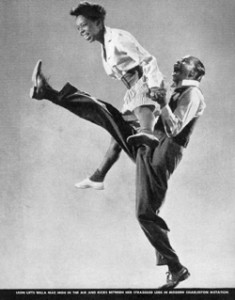 The Lindy Hop was born in black communities in Harlem, New York in the United States from about 1927 into the early 1930’s from four possible sources: the breakaway, the Charleston, the Texas Tommy, and the hop.
The Lindy Hop was born in black communities in Harlem, New York in the United States from about 1927 into the early 1930’s from four possible sources: the breakaway, the Charleston, the Texas Tommy, and the hop.
One alleged source of the dance’s name is famed aviator Charles Lindbergh, nicknamed “Lucky Lindy” in 1926. After Lindbergh’s solo non-stop flight from New York to Paris in which he “hopped” the Atlantic in 1927, headlines in the newspapers in 1928 read “Lindy hops the Atlantic.”
According to Ethel Williams, the Lindy Hop was similar to the dance known as the Texas Tommy in New York in 1913. The basic steps in the Texas Tommy were followed by a breakaway identical to that found in the Lindy. Savoy dancer “Shorty” George Snowden stated that “We used to call the basic step the Hop long before Lindbergh did his hop across the Atlantic. It had been around a long time and some people began to call it the Lindbergh Hop after 1927, although it didn’t last. Then, during the marathon at Manhattan Casino, I got tired of the same old steps and cut loose with a breakaway…” According to Snowden, Fox Movietone News covered the marathon and took a close-up of Shorty’s feet. As told to the Stearns, he was asked “What are you doing with your feet,” and replied, “The Lindy”. The date was June 17, 1928.
The first generation of Lindy Hop is popularly associated with dancers such as “Shorty” George Snowden, his partner Big Bea, and Leroy Stretch Jones and Little Bea. “Shorty” George and Big Bea regularly won contests at the Savoy Ballroom. Their dancing accentuated the difference in size with Big Bea towering over Shorty. These dancers specialized in so-called floor steps.
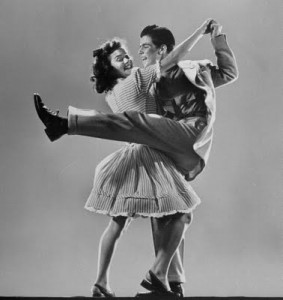 As white people began going to Harlem to watch black dancers, according to Langston Hughes: “The lindy-hoppers at the Savoy even began to practice acrobatic routines, and to do absurd things for the entertainment of the whites, that probably never would have entered their heads to attempt for their own effortless amusement. Some of the lindy-hoppers had cards printed with their names on them and became dance professors teaching the tourists. Then Harlem nights became show nights for the Nordics.”
As white people began going to Harlem to watch black dancers, according to Langston Hughes: “The lindy-hoppers at the Savoy even began to practice acrobatic routines, and to do absurd things for the entertainment of the whites, that probably never would have entered their heads to attempt for their own effortless amusement. Some of the lindy-hoppers had cards printed with their names on them and became dance professors teaching the tourists. Then Harlem nights became show nights for the Nordics.”
Charles Buchanan, manager of the Savoy, paid dancers such as Shorty Snowden to “perform” for his clientele. According to Snowden, “When he finally offered to pay us, we went up and had a ball. All we wanted to do was dance anyway.” When “Air steps” or “aerials” such as the Hip to Hip, Side Flip, and Over the Back (the names describe the motion of the woman in the air) began to appear in 1936, the old guard of dancers such as Leon James, Leroy Jones, and Shorty Snowden disapproved of the new moves.
Younger dancers fresh out of high school (Al Minns, Joe Daniels, Russell Williams, and Pepsi Bethel) worked out the Back Flip, Over the head, and ‘the Snatch.’
Whiteys Lindy Hoppers: From the film Hellzapoppin
Probably the greatest Lindy hop sequence ever filmed. Whitey’s Lindy Hoppers from the film Helzapoppin.
Frankie Manning was part of a new generation of Lindy Hoppers, and is the most celebrated Lindy Hopper in history. Al Minns and Pepsi Bethel, Leon James, and Norma Miller are also featured prominently in contemporary histories of Lindy Hop. Some sources credit Frankie Manning, working with his partner Freida Washington, for inventing the ground-breaking ‘Air Step’ or ‘aerial‘ in 1935. One source credits Al Minns and Pepsi Bethel as among those who refined the air step. An Air Step is a dance move in which at least one of the partners’ two feet leave the ground in a dramatic, acrobatic style. Most importantly, it is done in time with the music. Air steps are now widely associated with the characterization of lindy hop, despite being generally reserved for competition or performance dancing, and not generally being executed on any social dance floor.
Lindy Hop entered mainstream American culture in the 1930’s, gaining popularity through multiple sources. Dance troupes, including the Whitey’s Lindy Hoppers (also known as the Harlem Congaroos), Hot Chocolates and Big Apple Dancers exhibited the Lindy Hop. Hollywood films, such as Hellzapoppin’ and A Day at the Races began featuring the Lindy Hop in dance sequences. Dance studios such as those of Arthur Murray and Irene and Vernon Castle began teaching Lindy Hop. By the early 1940’s the dance was known as “New Yorker” on the West Coast.
Lindy Hop moved off-shore in the 1930’s and 40’s, again in films and news reels, but also with American troops stationed overseas, particularly in the United Kingdom, Canada, Australia, New Zealand, and other allied nations. Although Lindy Hop and jazz were banned in countries such as Germany, both were popular in other European countries during this period.
In 1944, due to continued involvement in World War II, the United States levied a 30 percent federal excise tax against “dancing” nightclubs. Although the tax was later reduced to 20 percent, “No Dancing Allowed” signs went up all over the country.
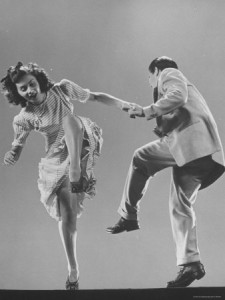 Post-swing era (1950’s–1960’s)
Post-swing era (1950’s–1960’s)
Arthur Murray’s 1954 edition of How to become a Good Dancer included four pages of instruction for Swing: the Basic Lindy Step, the Double Lindy Hop, the Triple Lindy Hop, the Sugar Foot Walk, and the Tuck-In Turn. A chapter is devoted to Lindy Hop in the 1953 and 1958 editions of Dancing Made Easy.
The 1962 Ballroom Dancebook for Teachers included an entire chapter on “Lindy.”
According to the book Social Dance, copyrighted in 1969, by 1960 The Lindy Hop was known as swing.
Revival (1980’s and 1990’s)
Sandra Cameron and Larry Schulz of the Cameron Dance Center Inc in New York were instrumental in bringing Al Minns and Frankie Manning back into teaching Lindy Hop at their dance center. Minns joined the dance center and began a swing program there in 1981. Frankie Manning joined the Center in 1985.
Al Minns’ early students formed the basis for the New York Swing Dance Society, established in 1985.
In the 1980’s, American and European dancers from California, New York, London and Sweden (such as Sylvia Sykes, Erin Stevens, Steven Mitchell, Terry Monaghan and Warren Heyes who formed London’s Jiving Lindy Hoppers performance troupe, and Stockholm’s Rhythm Hot Shots / Harlem Hot Shots) went about ‘reviving’ Lindy Hop using archival films such as Hellzapoppin’ and A Day at the Races and by contacting dancers such as Frankie Manning, Al Minns, Norma Miller, Jewel McGowan and Dean Collins. In the mid-to-late 1990s the popularity of neo swing music of the swing revival stimulated mainstream interest in the dance. The dance was propelled to wide visibility after it was featured in movies such as Swing Kids in 1993 and in the “Kakhis Swing” television commercials for GAP in 1998. The popularity led to the founding of local Lindy Hop dance communities in many cities.
In 1999, Swing! opened up on Broadway, featuring world-class lindy hoppers Jenny Thomas and Ryan Francois, Latin swing dancer Maria Torres and her partner Carlos Sierra-Lopez, country swing stars Robert Royston and Laureen Baldovi, and west coast swing couple Beverly Durand and Aldrin Gonzales. Carol Bentley, Scott Fowler, Caitlin Carter, Edger Godineaux, Geralyn Del Corso, and Keith Lamelle Thomas were also featured in various swing-related dance pieces in the Tony-nominated show during its run at the St. James Theatre. The show closed in January 2001, yet continues to be set in regional and international cities around the world.
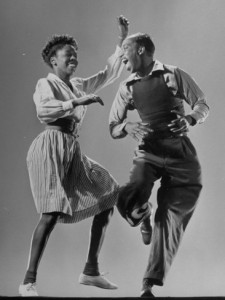 Current status – Lindy Hop Today
Current status – Lindy Hop Today
There are thriving communities throughout the world, and Lindy Hop can today be found in almost every large westernized city.
The small village of Herräng in Sweden (north of Stockholm) has unofficially become the international mecca of Lindy Hop thanks to the annual Herräng Dance Camp formerly run by the Rhythm Hot Shots then passed on to new owners and operational team, with an attendance from around 40 countries. Lindy Hop tends to be concentrated in small local scenes in cities in each of these countries, although regional, national, and international dance events bring dancers from many of these scenes together. Local swing dance communities in each city and country feature different local cultures. The concept of a Lindy exchange, a gathering of lindy hop dancers in one city for several days to dance with visitors and locals, enables different communities to share their ideas with others.
Lindy Hop today is danced as a social dance, as a competitive dance, as a performance dance, and in classes, workshops, and camps. In each, partners may dance alone or together, with improvisation a central part of social dancing and many performance and competition pieces.

